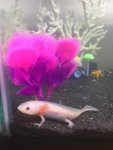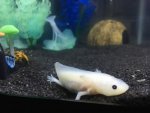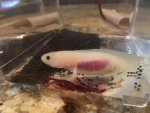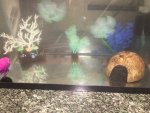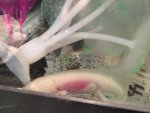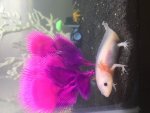I have always wanted an axolotl, and my friend surprised me by getting me one for my birthday. However, I was not prepared enough to know how to take care of one, and tried to use all the websites and things I could when setting up his tank. The tank has black sand that I thoroughly washed, a good filter built for up to 20 gallons even though mine is a 10 gallon, and I have several plastic plants and a plastic coconut for my axie to hide in. i treated the water with water conditioner and keep it around 59-62 degrees F using a fan. My axolotl was fine for a few days, just kind of hiding in a corner as he got used to the tank, then he worked his way over to the coconut which he stayed under for most of the day and then would come out at night and wander around the other side of the tank. Twice he did this thing where he was still under the coconut, then darted out and up, swam vertically to the other side of the tank, swam up to the water, then darted back down onto the sand and stayed still. Does anyone know if that is normal or a sign of stress or anything??
Also, yesterday I came home to him sitting in a new corner of the tank, completely still, with some of his arms and legs even up, with barely any color in his gill branches anymore. He's a leucistic type and he's a baby. Now he's barely moving, and has stayed in one area of the tank completely still overnight. This isn't how he's acted the past week that I had him and I'm afraid I've done something wrong. I tested the water and it's about: GH-120 ppm, KH-180 ppm, pH- 7.5, nitrite-0.5 ppm, nitrate- 20 ppm. I also feed him frozen bloodworms which he has been loving up until this point. The first time he was not moving and I thought he was dead I dropped some bloodworms over by him and he darted out of the way. This time he just let them fall on him. If I take my forceps and nudge him a few times he'll spaz out a little and then return to being completely still. What do I do??? Is he dying? I'll post pictures below of how he looked when he was acting normal and how he looks now, taken about 3 days apart. I am also leaving school today and need to drive him back with me for 4.5 hours in the car. I'm afraid that in his fragile state, transportation will be too much for him. Opinions please? Thank you!
Also, yesterday I came home to him sitting in a new corner of the tank, completely still, with some of his arms and legs even up, with barely any color in his gill branches anymore. He's a leucistic type and he's a baby. Now he's barely moving, and has stayed in one area of the tank completely still overnight. This isn't how he's acted the past week that I had him and I'm afraid I've done something wrong. I tested the water and it's about: GH-120 ppm, KH-180 ppm, pH- 7.5, nitrite-0.5 ppm, nitrate- 20 ppm. I also feed him frozen bloodworms which he has been loving up until this point. The first time he was not moving and I thought he was dead I dropped some bloodworms over by him and he darted out of the way. This time he just let them fall on him. If I take my forceps and nudge him a few times he'll spaz out a little and then return to being completely still. What do I do??? Is he dying? I'll post pictures below of how he looked when he was acting normal and how he looks now, taken about 3 days apart. I am also leaving school today and need to drive him back with me for 4.5 hours in the car. I'm afraid that in his fragile state, transportation will be too much for him. Opinions please? Thank you!

